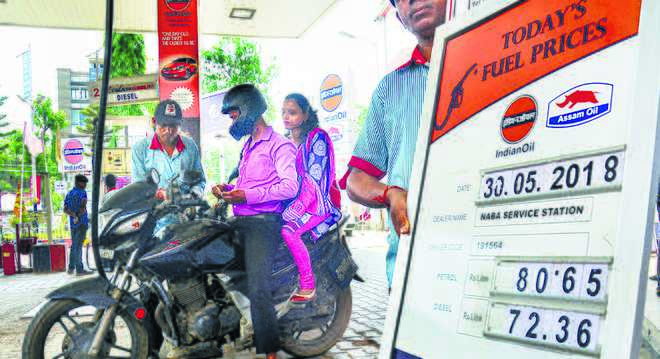
OIL CRISIS: Passing through higher fuel prices at the retail level has created general unrest over the impact on consumers.
Sushma Ramachandran
Senior Financial Journalist
SOARING global oil prices have created a crisis for the Indian economy. From just about $ 44 per barrel at the end of 2016, crude oil is now ruling at around $78 to 80 per barrel. The phenomenal rise has completely upset the government's fiscal calculations. And the hardening trend has come just a year before the country is due to face the general election, making it a political flashpoint.
Passing through higher fuel prices at the retail level has created general unrest over the impact on consumers. At the same time, cutting oil tariffs will be unwise as such a short-term measure will lead to widening of the fiscal deficit.
The crisis reminds us that the country needs to make a gradual shift from the focus on crude oil to increasing utilisation of other energy sources like natural gas.
Energy mix
Currently, the share of natural gas in total energy availability is about 6.5 per cent. The aim is to raise this to 15 per cent by 2030. Simultaneously, a 10 per cent cut in oil imports is planned by 2022. But the share of crude oil in the energy mix has not shown any signs of reducing over the past few years.
This is despite various options being considered over the past few decades to reduce the heavy dependence on crude oil. India is already a participant in the proposed Turkmenistan-Afghanistan-Pakistan-India (TAPI) pipeline project meant to utilise natural gas supplies from Central Asia. It has, unfortunately, been proceeding at a snail’s pace since its groundbreaking in 2015.
LNG imports
India has also set up LNG (liquefied natural gas) port terminals to handle imports from Qatar, the US, Australia and recently, Russia. But importing LNG by tanker is more expensive than the pipeline route.
No wonder then that several proposals have been considered in the past two decades to import gas via pipelines from countries in the nearby West Asia. These include proposals for a deep sea pipeline from Oman to India and also the much-publicised Iran-Pakistan-India overland pipeline project. Neither of these took off due to various reasons, including the strategic aspects of the proposals.
Yet another gas pipeline plan from West Asia to India is now being mooted by a private consortium, the South Asia Gas Enterprise (SAGE) in collaboration with global partners. This appears to be even more ambitious than the earlier proposals. It envisages a pipeline network from Iran, the UAE and Qatar and other West Asia countries that would form a gas super-highway. It would be laid on a deep sea route that would become an energy corridor to this country, bypassing the security concerns that hung like a cloud over the IPI pipeline project.
The many advantages of such a pipeline include the lower cost of transport as compared to LNG supplies via tankers, ability to enter into long-term contracts for several decades and the consequent possibility of linking gas supplies to greenfield fertilisers or petrochemical projects.
The latter need assured feedstock availability before even being set up. It also becomes an addition to the existing bouquet of energy sources for the country. While LNG imports will continue to remain a mainstay in the natural gas sector, some supplies may be available from the TAPI pipeline as well as from domestic output which meets about half of the current demand.
The availability from a deep-sea pipeline emanating in West Asia would provide yet another element of energy security for the country.
US a roadblock
The ambitious proposal, however, will come across serious roadblocks before being given any serious consideration by policymakers in this country. The most critical one is the US angst over India's dealings with Iran in the area of petro-products now that sanctions are back in place. It is possible that the sanctions are only on petroleum and not on natural gas as was the case in the previous round of the US sanctions on Iran. But there is yet no clarity on this issue though some countries which have long term supply contracts like Turkey have maintained they will continue to buy from that country as there is simply no other option.
Even in the case of Iran’s oil exports, the earlier Obama administration had been satisfied with 20 to 30 per cent cut in purchases. The current US administration, however, may take a much harder line. Much will depend on the negotiations on this issue between India and the US. These will also look at the prospects of India’s involvement in the development of a gas field in Iran.
The fact is, however, that diversifying the sources of energy is imperative for this country. A deep sea pipeline stretching from West Asia to India is a futuristic proposal right now but will be yet another way of insulating the country from the vagaries of the international oil market. Currently, India is importing over 80 per cent of its crude oil needs and the oil import bill was $ 88 billion in the last fiscal. It will be much higher this year. Increasing the share of natural gas in the energy basket is thus becoming imperative.
It must also be pointed out that India's natural gas consumption is one of the lowest in the world at 80 cubic metres per person as compared to 253 cubic metres for Bangladesh and 152 cubic metres for China.
Whether this proposal becomes a reality or not, it is high time for an accelerated approach towards ensuring that the Indian economy has access to a wide range of energy sources. This becomes not just an economic necessity but also a strategic imperative for all countries in the current delicate geopolitical environment where conflicts could erupt at any time in any region.



























